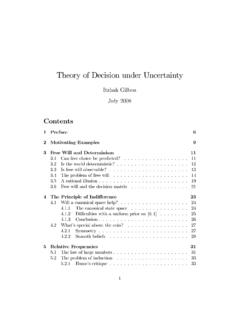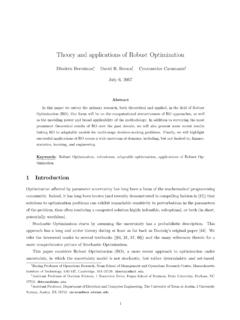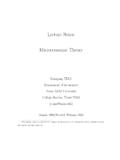Transcription of Statistical Decision Theory: Concepts, Methods and ...
1 Statistical Decision theory : Concepts, Methods and Applications (Special topics in Probabilistic Graphical Models) FIRST COMPLETE DRAFT November 30, 2003 Supervisor: Professor J. Rosenthal STA4000Y Anjali Mazumder 950116380 Part I: Decision theory Concepts and Methods 1 Part I: Decision theory - Concepts and Methods Decision theory as the name would imply is concerned with the process of making decisions. The extension to Statistical Decision theory includes Decision making in the presence of Statistical knowledge which provides some information where there is uncertainty.
2 The elements of Decision theory are quite logical and even perhaps intuitive. The classical approach to Decision theory facilitates the use of sample information in making inferences about the unknown quantities. Other relevant information includes that of the possible consequences which is quantified by loss and the prior information which arises from Statistical investigation. The use of Bayesian analysis in Statistical Decision theory is natural. Their unification provides a foundational framework for building and solving Decision problems.
3 The basic ideas of Decision theory and of Decision theoretic Methods lend themselves to a variety of applications and computational and analytic advances. This initial part of the report introduces the basic elements in ( Statistical ) Decision theory and reviews some of the basic concepts of both frequentist statistics and Bayesian analysis. This provides a foundational framework for developing the structure of Decision problems. The second section presents the main concepts and key Methods involved in Decision theory . The last section of Part I extends this to Statistical Decision theory that is, Decision problems with some Statistical knowledge about the unknown quantities.
4 This provides a comprehensive overview of the Decision theoretic framework. Part I: Decision theory Concepts and Methods 2 Section 1: An Overview of the Decision Framework: Concepts & Preliminaries Decision theory is concerned with the problem of making decisions. The term Statistical Decision theory pertains to Decision making in the presence of Statistical knowledge, by shedding light on some of the uncertainties involved in the problem. For most of this report, unless otherwise stated, it may be assumed that these uncertainties can be considered to be unknown numerical quantities, denoted by.
5 Decision making under uncertainty draws on probability theory and graphical models. This report and more particularly this Part focuses on the methodology and mathematical and Statistical concepts pertinent to Statistical Decision theory . This initial section presents the decisional framework and introduces the notation used to model Decision problems. Section : Rationale A Decision problem in itself is not complicated to comprehend or describe and can be simply summarized with a few basic elements. However, before proceeding any further, it is important to note that this report focuses on the rational Decision or choice models based upon individual rationality.
6 Models of strategic rationality (small-group behavior) or competitive rationality (market behavior) branch into areas of game theory and asset pricing theory , respectively. Thus for the purposes of this report, these latter models have been neglected as the interest of study is Statistical Decision theory based on individual rationality. In a conventional rational choice model, individuals strive to satisfy their preferences for the consequences of their actions given their beliefs about events, which are represented by utility functions and probability distributions, and interactions among individuals are governed by equilibrium conditions (Nau, 2002[1]).
7 Decision models lend themselves to a Decision making process which involves the consideration of the set of possible actions from which one must choose, the circumstances that prevail and the consequences that result from taking any given action. The optimal Decision is to make a choice in such a way as to make the consequences as favorable as possible. As mentioned above, the uncertainty in Decision making which is defined as an unknown quantity, , describing the combination of prevailing circumstances and governing laws , is referred to as the state of nature (Lindgren, 1971).
8 If this state is unknown, it is simple to select the action according to the favorable degree of the consequences resulting from the various actions and the known state. However, in many real problems and those most pertinent to Decision theory , the state of nature is not completely known. Since these situations create ambiguity and uncertainty, the consequences and subsequent results become complicated. Decision problems under uncertainty involve many diverse ingredients - loss or gain of money, security, satisfaction, etc., (Lindgren, 1971).
9 Some of these ingredients can be assessed while some may be unknown. Nevertheless, in order to construct a mathematical framework in which to model Decision problems, while providing a rational Part I: Decision theory Concepts and Methods 3basis for making decisions, a numerical scale is assumed to measure consequences. Because monetary gain is often neither an adequate nor accurate measure of consequences, the notion of utility is introduced to quantify preferences among various prospects which a Decision maker may be faced with.
10 Usually something is known about the state of nature, allowing a consideration of a set of states as being admissible (or at least theoretically so), and thereby ruling out many that are not. It is sometimes possible to take measurements or conduct experiments in order to gain more information about the state. A Decision process is referred to as Statistical when experiments of chance related to the state of nature are performed. The results of such experiments are called data or observations. These provide a basis for the selection of an action defined as a Statistical Decision rule.









